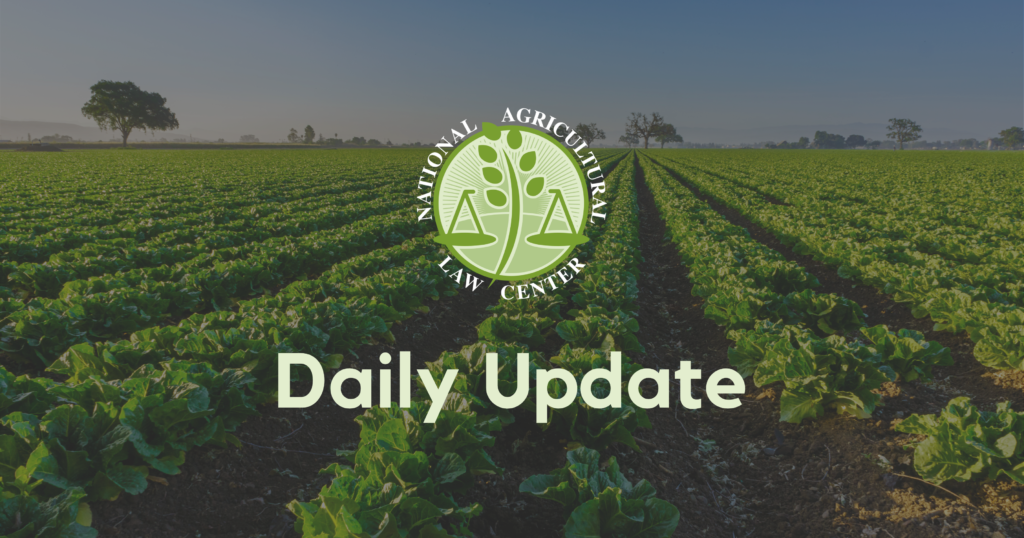A comprehensive summary of today’s judicial, legislative, and regulatory developments in agriculture and food. Email important additions HERE.
JUDICIAL: Includes CWA
In Hawai’i Wildlife Fund v. Cty. of Maui, No. CV 12-00198 SOM/KJM, 2021 WL 3007168 (D. Haw. July 15, 2021), a federal court in the District of Hawai’i considered whether the County of Maui (“the County”) was required to obtain a National Pollutant Discharge Elimination System (“NPDES”) permit pursuant to the Clean Water Act (“CWA”) for discharges made from a wastewater reclamation facility owned by the County. The discharges from the facility are made into groundwater, which is not traditionally protected by the CWA, and from there travel to the Pacific Ocean which does fall under CWA jurisdiction. This decision from the court is the latest installment of a multi-year litigation which ultimately made its way to the United States Supreme Court where the justices ruled that some discharges into groundwater (or some other medium) would require NPDES permits if those discharges were the “functional equivalent” of a direct discharge. After reaching that decision, the Supreme Court sent the matter back to the lower courts to determine whether the County was required to obtain a NPDES permit for discharges from its wastewater facility. Ultimately, the lower court determined that a permit would be necessary.
In its decision, the Supreme Court issued guidance for when a discharge would be considered the functional equivalent of a direct discharge. That guidance included some factors that should be considered, the most important of which is the amount of time it takes discharged pollutants to reach a protected waterbody, and the amount of distance the pollutants travel. The remaining factors are primarily concerned with the overall integrity of the pollutants by the time they reach protected waters. In this case, the court determined that the various factors weighed in favor of requiring a NPDES permit.
First, the court considered the time it took for pollutants discharged from the County’s wastewater reclamation facility to reach the Pacific Ocean. According to the court, some of the pollutants reached the Pacific in as little as 84 days, while the remained took between 9 and 10 months. While the court noted that this was not instantaneous, it still concluded that it weighed in favor of requiring a NPDES permit because it was short of the “many years” extreme that the Supreme Court had determined would be too long to find a permit was necessary. Next, the court found that the distance the pollutants traveled also weighed in favor of requiring a NPDES permit because it was, at most, 1.5 miles. Finally, the court considered the remaining factors concerning how much of the discharged pollutants reached the Pacific, and the overall integrity of the pollutants once they got there. The court found that those factors also weighed in favor of requiring a NPDES permit because there was concrete evidence that polluted wastewater discharged from the wastewater reclamation facility reached the Pacific Ocean.
The court ruled that the Count was required to obtain a NPDES permit for discharges from the wastewater reclamation facility because the various factors outlined by the Supreme Court favored requiring a permit in this case. This decision represents the first time a court has applied those factors.
REGULATORY: APHIS, EPA, FSA, FSIS, USDA
ANIMAL AND PLANT HEALTH INSPECTION SERVICE
Notice announcing the Animal and Plant Health Inspection Service’s intention to request a revision to and extension of approval of an information collection associated with the National Poultry Improvement Plan. Info here.
Notice advising the public that APHIS prepared a final environmental assessment and finding of no significant impact relative to permitting the release of Ramularia crupinae for the biological control of common crupina (Crupina vulgaris) in the contiguous United States. Info here.
Notice advising the public of a proposition to exempt plants with additional modifications that could otherwise be achieved through conventional breeding from the regulations that govern the introduction of certain organisms modified or produced through genetic engineering. Info here.
ENVIRONMENTAL PROTECTION AGENCY
Proposed rule publishing a draft list of contaminants that are currently not subject to any proposed or promulgated national primary drinking water regulations for public review and comment. Info here.
Final rule amending several New Source Review regulations. Info here.
Notice in accordance with the Clean Air Act, EPA gives notice of a proposed consent decree in Environmental Integrity Project v. Regan, No. 1:21-cv-00009 (D.D.C.). Info here.
FARM SERVICE AGENCY
Notice announcing the availability of funds for the Pandemic Livestock Indemnity Program to provide assistance to producers for losses of livestock and poultry depopulated from March 1, 2020, through December 26, 2020 due to insufficient processing access as a result of the COVID-19 pandemic and for the cost of depopulation and disposal. Info here.
FOOD SAFETY AND INSPECTION SERVICE
Notice announcing that the FSA has updated two of its guidelines for minimizing the risk of Shiga toxin-producing Escherichia coli (STEC) in beef slaughter (including veal) and processing operations. Info here.
Notice responding to two recommendations from the USDA Office of Inspector General regarding the Agency’s rulemaking process for the proposed rule entitled Modernization of Swine Slaughter Inspection, that included the proposal to establish the New Swine Slaughter Inspection System. Info here.
UNITED STATES DEPARTMENT OF AGRICULTURE
Notice announcing an extension for the comment period seeking input from the public on how the USDA can advance racial justice and equity for underserved communities as part of its implementation of Executive Order 13985, Advancing Racial Equity and Support for Underserved Communities Through the Federal Government. Info here.
